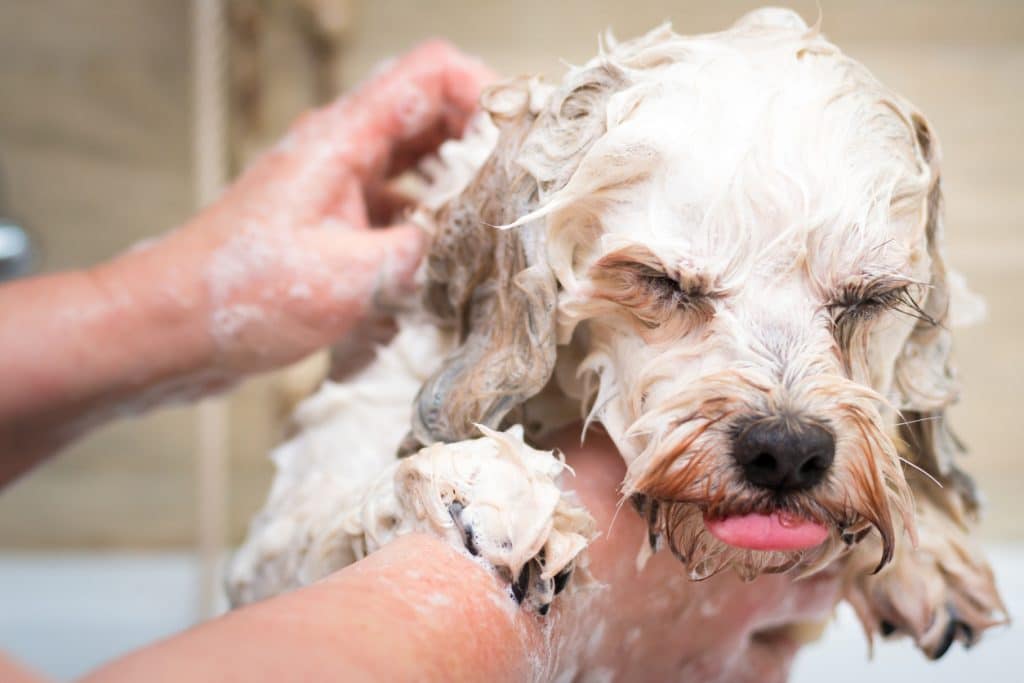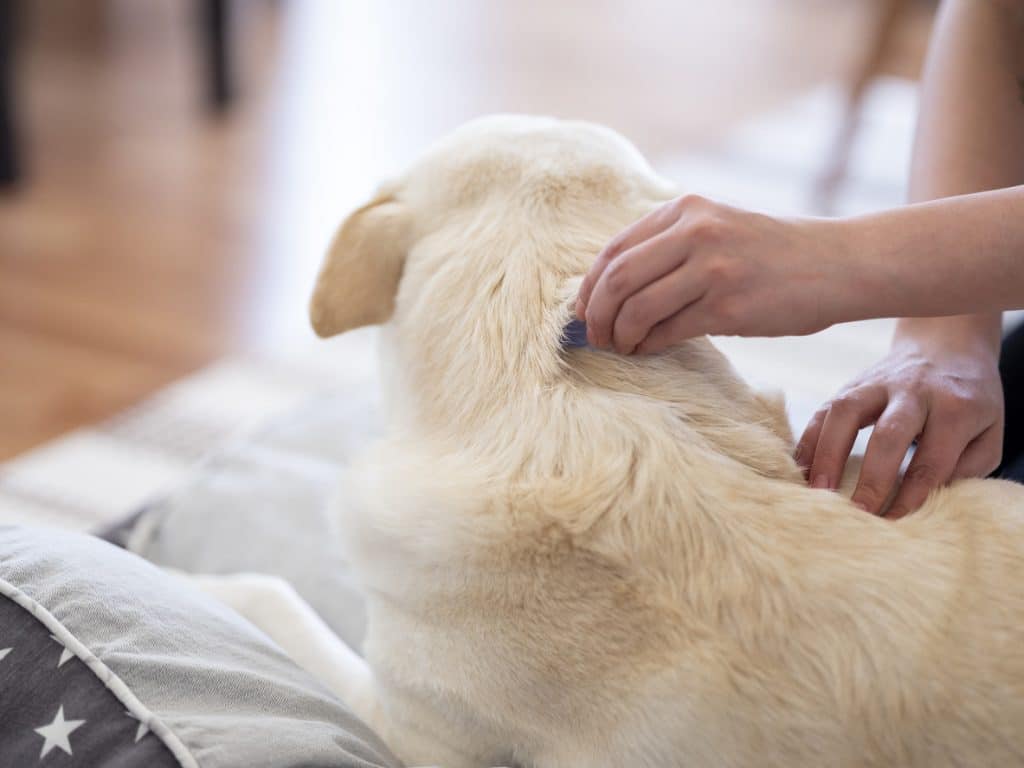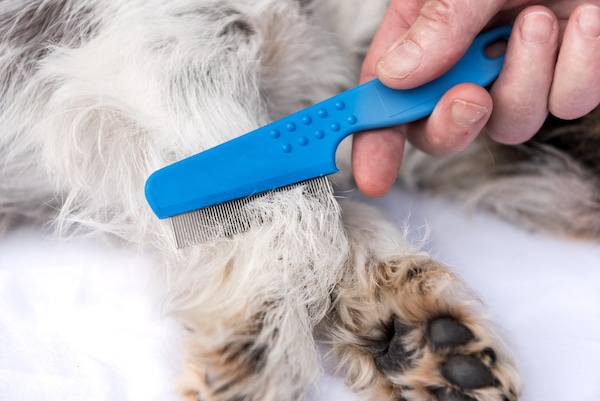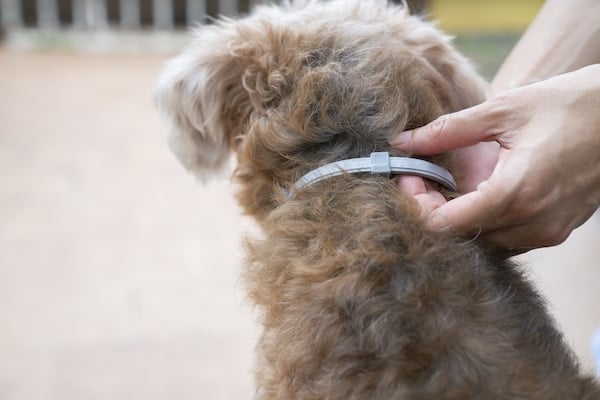- This post contains affiliate links. Read more here.
- Not a substitute for professional veterinary help.
Fleas are no fun for anyone: pets and pet parents alike. But sometimes, a single flea bite is more than just a pesky nuisance. Both cats and dogs can develop flea allergy dermatitis (FAD), a severe allergic reaction to the antigens in a flea’s saliva. In fact, flea allergy dermatitis is one of the most common dermatologic conditions affecting dogs in the U.S.
Unsurprisingly, the condition is most pronounced in the summer—prime time for fleas. Signs of FAD are easy to spot: a dog allergic to fleas will develop incessant itching, primarily on the lower back and legs. They may also develop sores, scabs, red skin, and hair loss in the affected areas.
The good news is that while unpleasant, FAD is treatable. To kill the fleas on your pet and ease his discomfort, your vet may prescribe topical or oral medications. Topical treatments can take 12 to 36 hours to eliminate fleas, whereas pills will work more quickly. Complete elimination of a flea infestation can take several weeks, however, because of the range in a flea’s reproductive cycle.
As such, regular monthly flea prevention is your best bet to avoid an infestation or painful reaction altogether. To learn how to treat a flea allergy in dogs, we interview two veterinary dermatologists: Dr. Rachel Caines, a veterinary surgeon and dermatologist practicing at Knutsford Vets Surgery, and Dr. Alexandra Gould, a veterinary dermatologist at Seattle-based Pet Dermatology Partners.
Here’s everything you need to know about flea allergy dermatitis—and how to get your dog some relief.
What Are the Symptoms of Flea Allergy Dermatitis?
When a flea bites your dog, it injects saliva into your pet’s skin. For non-allergic dogs, this amounts to nothing more than an annoying itch. But for dogs who are sensitive to the histamine-like compounds in the flea’s saliva, severe itching and discomfort can follow.

magdasmith via iStock
Here are some common flea allergy dermatitis symptoms to watch for:
- Severe itching: This can manifest over the entire body, but is most pronounced in the “pants” area of the lower back and hind legs
- Erythema: Redness of the skin
- Hyperpigmentation: Increased darkness of the skin
- Excoriations: Visible scratches
- Hot spots: Well-defined areas of moist, inflamed skin that can cause oozing
- Sores: Small red bumps covered with crusting and scabs
- Hair loss: Incessant licking can wear away hair, and may also stain it brown
- Lichenified skin: Thickened skin from constant rubbing
- Secondary infection: Bacterial infections can occur and manifest with crusting and scaliness (white flakes in your dog’s coat or skin)
- Restlessness and visible discomfort: Dogs with FAD will appear agitated, constantly scratching, chewing, and rubbing their skin
How Do You Treat a Dog Allergic to Fleas?
First things first: those fleas have to go—stat. Your dog’s comfort (and sanity) are counting on it.
You can start your dog’s flea allergy treatment using a flea comb to weed out adult fleas, eggs, and icky debris. Using a medicated flea shampoo is also helpful, Dr. Rachel Caines tells us. “Soothing and calming shampoos can help a little with the itching and help the skin to heal.” Look for a formula with ingredients like aloe, lanolin, and oatmeal that are gentle on sensitive skin.

iStock/sestovic
Washing your dog’s bed and any linens or blankets in hot water will kill fleas and their larvae.
Dr. Alexandra Gould stresses that getting a flea infestation under control also requires treatment of the home and yard. “It’s important to treat the house as well,” she says. “There are companies that can provide pet-safe treatments for fleas in the house, and there are also area sprays that a veterinarian can provide.”
When should you see a vet if you suspect a flea allergy? “As soon as possible,” Dr. Caines advises. “The sooner the condition is treated and prevented, the faster your dog will have relief and the shorter the duration of symptoms will be.”
To relieve your dog’s itch, your vet might prescribe antihistamines or steroids, Dr. Gould tells us. “For pets that are experiencing a flare, a short course of steroids in addition to treating the fleas in the household can be very helpful to relieve their discomfort.” Because results can be variable, desensitizing pets to fleas is rarely used to treat a flea allergy.

iStock/temizyurek
How Is a Dog Flea Allergy Diagnosed?
In most cases, an examination of your dog’s symptoms and a review of his health history are enough to reach a diagnosis of FAD. However, occasionally allergy tests are used when a diagnosis is unclear or for dogs who suffer from additional allergies.
| Type of Test | What It Is and What It Looks For |
| Clinical evaluation | A vet will look for clinical signs of FAD, including flea dirt and fleas themselves. They will also look at your pet’s history of developing itching on the rump or of seeing fleas on the pet. |
| Intradermal skin testing | A small amount of flea extract is injected under your dog’s skin to measure the strength of your dog’s sensitivity. |
| Blood tests | These look for antibodies in the bloodstream. They aren’t frequently required for diagnosis. |
| Acetate tape strip cytology | Using tape, your vet will collect a sample of a lesion to determine the presence of a secondary bacterial infection. |
How Can I Prevent Flea Allergy Dermatitis?
The number one rule of flea control is prevention, Dr. Gould confirms. “The most important thing you can do is make sure all pets in the household are on a flea preventative medication year-round. Additionally, in some parts of the country where fleas are prevalent, using a flea preventative that contains a repellant is even better because it will stop the fleas from biting the pet at all.”
To prevent future outbreaks, your vet may prescribe a monthly oral medication, such as Nexgard or Comfortis. Topical treatments such as Frontline Plus II and K9 Advantix II are another option. While a pill’s effect is almost immediate, a topical treatment can take up 36 hours for results to appear.
Dosage for both pills and topicals are based on your pet’s weight, so be sure to check those carefully. And if you’re looking to save money, you may want to consider purchasing in bulk. Buying monthly doses might be cheaper upfront, but getting a 6- or 12-month bundle will save you more in the long run.
Do Natural Flea Remedies Work?
As far as natural flea preventatives go, opinions are somewhat mixed. If you’re planning on taking the natural route, Dr. Gary Richter, Rover’s resident veterinarian on the Dog People Panel, recommends sticking with products intended for dogs, rather than mixing your own concoction. And while Dr. Richter acknowledges that essential oil-based products can repel pests, they’re only effective for a few hours and require multiple applications.

K_Thalhofer via iStock
“Natural is never going to work as blanketed as pharmaceuticals will,” Dr. Richter explains. “So if your goal is to get down to zero fleas and ticks, then natural is not going to work as best.” Dr. Gould agrees, telling Rover, “Natural remedies can sometimes be toxic, and are never as effective [as prescribed medication].”
Moreover, Dr. Gould stresses that natural remedies are no replacement for year-round prescribed preventatives. “Really, the best thing is to treat the fleas is using a safe, prescribed mediation, treating all pets in the household, and preventing future flares of flea allergy dermatitis by using a flea preventative year-round on all pets.”
What About Flea Collars?
Flea collars give off chemicals designed to either repel fleas or kill them even before they bite your pet. They’ve come under scrutiny in recent years, which has made many pet parents wary.
Dr. David Littlejohn of Pawscessories says that flea collars are generally safe but species-dependent; dogs should never wear flea collars designed for cats and vice versa.

Tatomm via iStock
It’s possible that your dog could have an allergy to the chemicals used on a flea collar—but that’s true of almost any flea treatment or medication, which is why it’s a good idea to check in with your vet before starting a course of treatment or choosing a preventative.
The bigger issue with flea collars, Dr. Littlejohn told us, is that they’re typically not very effective. Their affordability makes them attractive to pet parents, but they offer a false sense of security. “How well they actually protect pets from fleas is up for debate,” Dr. Littlejohn says, “but over time they’re becoming increasingly obsolete compared to oral or topical treatments.”
Those oral and topical treatments may be more expensive—but according to Dr. Littlejohn, they’re also much more effective.
Can All Dogs Get Flea Allergy Dermatitis?
Yes, all dogs can develop FAD at any age, although it’s unlikely to occur before the age of one. Unfortunately, dogs who suffer from other allergies (environmental or food) are more likely to be sensitive to flea bites. And, naturally, dogs who live in muggy climates and spend a good amount of time outdoors face greater risk of flea exposure.
Since all dogs can be sensitive to fleas, Dr. Caines emphasizes that year-round prevention is key: “Any dog not protected against routine parasite control is at risk of developing flea allergy dermatitis,” she says. The good news? Flea prevention is as simple as administering a monthly pill or topical. So consider it an easy task you can check off your pet-care to-do list right away!





